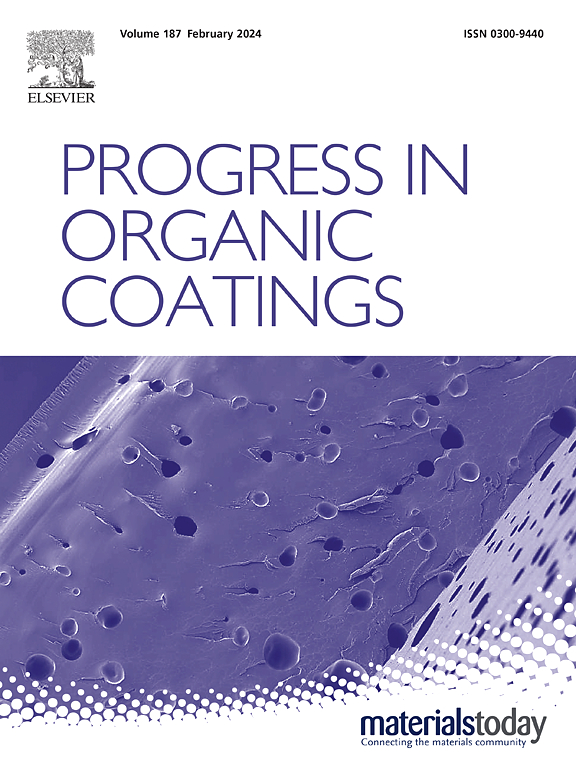通过树脂共聚优化钢结构膨胀防火涂料的膨胀和焦化强度
IF 7.3
2区 材料科学
Q1 CHEMISTRY, APPLIED
引用次数: 0
摘要
膨胀防火涂料(IFRC)广泛应用于钢结构。涂料的防火性能与其膨胀率和炭渣强度密切相关。然而,这些属性往往是矛盾的。最近的研究表明,树脂性能在膨胀和炭化过程中起着至关重要的作用。本文以苯乙烯(St)、2-乙基己基丙烯酸酯(2Eha)和甲基丙烯酸异丁酯(iBma)为原料,通过悬浮聚合合成共聚物树脂,以调节IFRC的膨胀行为和焦强度。采用实验表征和密度泛函理论(DFT)相结合的方法,分析了由聚合诱导相分离(PIPS)形成的塑化填料和氢键交联层组成的三元共聚物的多层结构。然后评估了由共聚物树脂制成的ifrc的膨胀和焦化强度,并讨论了多层结构对性能的积极影响。结果表明,2Eha显著提高了膨胀性能,而iBma和St提高了焦炭强度。优化后的IFRC由三元共聚物树脂(10 wt% iBma, 20 wt% 2Eha和70 wt% St)制备,将钢达到535℃失效温度的时间从1276 s(未涂层)延长到3236 s,安全时间增加了253%。此外,IFRC具有良好的阻燃性和低排烟性能,其峰值放热率(PHRR)为30.15 kW/m2,防火性能指数(FPI)为4.48 m2s/kW,火灾生长指数(FGI)为0.195 kW/m2/s,产烟率(SPR)为0.01649 m2/s。本文章由计算机程序翻译,如有差异,请以英文原文为准。

Optimizing expansion and char strength in steel structure intumescent fire-resistant coatings via resin copolymerization
Intumescent fire-resistant coatings (IFRC) are widely used for steel structures. The fire protection performance of the coating is closely related to its expansion and the strength of the char residue. However, these properties are often in contradiction. Recent studies suggest that resin properties play a crucial role in expansion and charring processes. Here, copolymer resins are synthesized using styrene (St), 2-ethylhexyl acrylate (2Eha), and isobutyl methacrylate (iBma), via suspension polymerization, to regulate the expansion behavior and char strength of the IFRC. Using experimental characterization combined with density functional theory (DFT), multilevel structures of the terpolymer are analyzed, consisting of plasticizing fillers formed by polymerization-induced phase separation (PIPS) and a crosslinked layer of hydrogen bonding. The IFRCs made of the copolymer resins are then evaluated for expansion and char strength, and the positive effects of the multilevel structures on performance are discussed. The results show that 2Eha significantly enhances the expansion performance, whereas iBma and St improve the char strength. The optimized IFRC, prepared from the terpolymer resin (10 wt% iBma, 20 wt% 2Eha, and 70 wt% St), extends the time to reach the steel failure temperature of 535 °C from 1276 s (uncoated) to 3236 s, a 253 % increase in the safe period. Additionally, the IFRC exhibits good flame retardancy and low smoke emission, with a peak heat release rate (PHRR) of 30.15 kW/m2, fire performance index (FPI) of 4.48 m2s/kW, fire growth index (FGI) of 0.195 kW/m2/s, and smoke production rate (SPR) of 0.01649 m2/s.
求助全文
通过发布文献求助,成功后即可免费获取论文全文。
去求助
来源期刊

Progress in Organic Coatings
工程技术-材料科学:膜
CiteScore
11.40
自引率
15.20%
发文量
577
审稿时长
48 days
期刊介绍:
The aim of this international journal is to analyse and publicise the progress and current state of knowledge in the field of organic coatings and related materials. The Editors and the Editorial Board members will solicit both review and research papers from academic and industrial scientists who are actively engaged in research and development or, in the case of review papers, have extensive experience in the subject to be reviewed. Unsolicited manuscripts will be accepted if they meet the journal''s requirements. The journal publishes papers dealing with such subjects as:
• Chemical, physical and technological properties of organic coatings and related materials
• Problems and methods of preparation, manufacture and application of these materials
• Performance, testing and analysis.
 求助内容:
求助内容: 应助结果提醒方式:
应助结果提醒方式:


